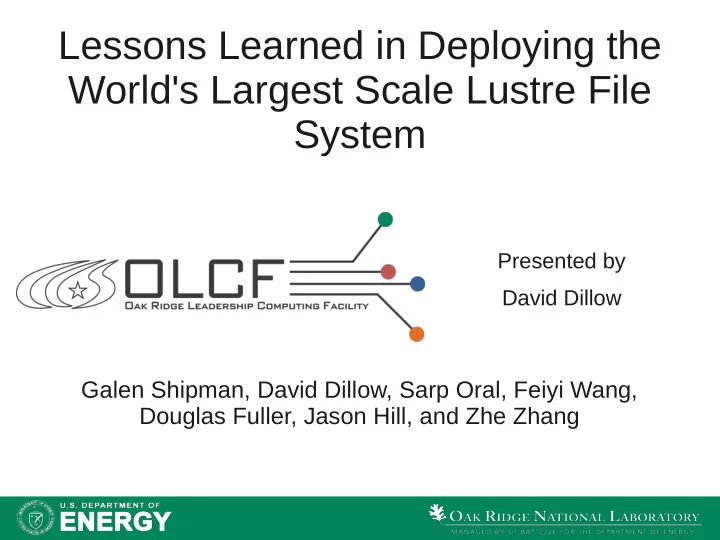

Lessons Learned in Deploying the World's Largest Scale Lustre File System Presented by David Dillow Galen Shipman, David Dillow, Sarp Oral, Feiyi Wang, Douglas Fuller, Jason Hill, and Zhe Zhang 1
Brief overview of Spider ● 10 PB storage to users ● 244 GB/s demonstrated bandwidth ● Currently serves 26,887 clients ● Based on Lustre 1.6.5 plus Cray and Oracle patches 2
Spider Hardware ● 13,696 1 TB SATA Drives ● 13,440 used for object storage ● 256 used for metadata and management ● 48 DDN 9900 Couplets (IB) ● 1 Engenio 7900 Storage Server (FC) ● 192 Dell PowerEdge 1950 Object servers ● 3 Dell R900 Metadata servers ● Other various management servers 3
Why Spider? ● Data availability ● Better MTTI/MTTF than locally attached Lustre ● Available during system maintenance periods ● Data accessibility ● No need to copy from simulation platform to visualization/analysis clusters ● Allows use of dedicated transfer nodes for movement off-site 4
What could go wrong? ● Interference from other systems ● Interactive performance ● Hardware failures ● Management headaches ● Lustre bugs ● Scapegoat syndrome 5
System Interference ● It's a shared resource ● Big jobs on the XT5 necessarily impact smaller clusters during heavy I/O ● Turns out to be mostly a non-issue ● Most users I/O needs seem to be more modest ● Occurs within a single cluster as well if multiple jobs are scheduled ● “Mostly....” 6
I/O Shadow 7
Metadata scaling ● Conventional wisdom is that one needs huge disk IOPS for metadata service ● Provisioned the Engenio for MDT ● RAID10 of 80 1 TB SATA disks ● Short stroked to an 8 TB volume ● Write-back caching enabled – With mirroring! ● Achieved 18,485 read and 23,150 write IOPS – 4 KB requests, random seeks over 8TB 8
Metadata scaling ● Conventional wisdom may be a bit inaccurate ● I/O rates very low during steady state operation – Bursts of ~1000 8K write requests every 5 seconds – Bursts of ~1500 to 3000 8K writes every 30 seconds – Occasional reads ● MDS memory sizing is paramount! – Try to fit working set size into memory – We have 32 GB which does well so far ● IOPS more important when cache cold after mount 9
Metadata scaling ● Lock pingpong hurts large jobs with shared files ● Opening a file with O_CREAT holds lock over a full round trip to client from MDS – 65,536 core job with O_CREAT takes 50 seconds – 65,536 core job without takes 5 seconds ● Lustre 1.8.3 fixes this if the file exists ● Still takes an exclusive lock, though ● But why does this hurt other jobs? 10
Metadata scaling ● Lock pingpong hurts interactivity due to Lustre's request model ● Every request is handled by a thread ● If the request needs to wait on a lock, it sleeps ● If you run out of threads, request handling stalls ● No quick fix for this ● Can bump up the thread count ● High thread counts can cause high CPU contention 11
Hardware failures ● We've dodged many bullets ● Server hardware has been very reliable ● Relatively few disk failures (one to two per week) ● More singlet failures than we'd like – Upper bound of about 2 per month – Some of those were likely software faults rather than HW – Multipath has had good results surviving a singlet failure 12
Hardware failures ● We've also had some issues ● SRP has had a few issues releasing the old connection ● Leaf modules in the core IB switches seem to prefer Byzantine failures ● OpenSM has not dealt gracefully with flapping links ● No one seems to make a good power supply ● MDS soft lockups ● OSTs transitioning to read-only due to external event 13
Management issues ● How do you find needles with particular attributes when you have 280 million of them? ● lfs find -R –obd <OST> – Over five days to complete ● Ne2scan – Almost two days ● Find – Three days with no arguments that require a stat call 14
Management issues ● Who is beating up the file system? ● Who is using the most space? ● How does our data and IO operation rates trend? ● Can we tie that to an application? 15
Scapegoat Syndrome ● Lustre has bugs ● Modern Lustre is much more of a “canary in the coal mine” than the walking trouble ticket it has been in the past ● User's first response is that “the file system is slow!” ● Even if the root cause is that the HSN is melting down 16
Questions? ● Contact info: David Dillow 865-241-6602 dillowda@ornl.gov 17
Recommend
More recommend